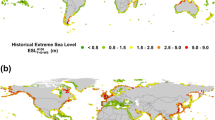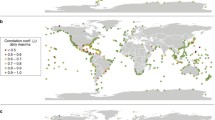Abstract
Tens of millions of people around the world are already exposed to coastal flooding from tropical cyclones. Global warming has the potential to increase hurricane flooding, both by hurricane intensification and by sea level rise. In this paper, the impact of hurricane intensification and sea level rise are evaluated using hydrodynamic surge models and by considering the future climate projections of the Intergovernmental Panel on Climate Change. For the Corpus Christi, Texas, United States study region, mean projections indicate hurricane flood elevation (meteorologically generated storm surge plus sea level rise) will, on average, rise by 0.3 m by the 2030s and by 0.8 m by the 2080s. For catastrophic-type hurricane surge events, flood elevations are projected to rise by as much as 0.5 m and 1.8 m by the 2030s and 2080s, respectively.
Similar content being viewed by others
References
Ali A (1996) Vulnerability of Bangladesh to climate change and sea level rise through tropical cyclones and storm surges. J Water Air Soil Pollut 92:171–179
Ali A (1999) Impacts and adaptation assessment in Bangladesh. Clim Res 12:109–116
Blake ES, Rappaport EN, Jarrell JD et al (2006) The deadliest, costliest, and most intense United States tropical cyclones from 1851 to 2005 (and other frequently requested hurricane facts). National Weather Service NWS TPC 4
Cañizares R, Irish JL (2008) Simulation of storm-induced barrier-island morphodynamics and flooding. Coast Eng 55:1089–1101
Cayan DR, Bromirski PD, Hayhoe K et al (2008) Climate change projections of sea level extremes along the California coast. Clim Change 87:57–73
Church JA, White NJ (2006) A 20th century acceleration in global sea-level rise. Geophys Res Lett 33:L01602
Danard M, Munro A, Murty T (2003) Storm surge hazard in Canada. Nat Hazards 28:407–431
Dean RG, Bender CJ (2006) Static wave setup with emphasis on damping effects by vegetation and bottom friction. Coast Eng 53:149–156
Demernard J, Sætra Ø, Røed LP (2002) Future wind, wave and storm surge climate in the northern North Atlantic. Clim Res 23:39–49
Elsner JB, Kossin JP, Jagger TH (2008) The increasing intensity of the strongest tropical cyclones. Nature 455:92–95
Emanuel KA, Živković-Rothman M (1999) Development and evaluation of a convection scheme for use in climate models. J Atmos Sci 56:1766–1782
Emanuel KA, Sundararajan R, Williams J (2008) Hurricanes and global warming: results from downscaling IPCC AR3 simulations. Bull Am Meteorol Soc 89:347–367
Federal Emergency Management Agency (2008) Hurricane Ike storm surge. FEMA high water marks. FEMA, Washington
Gonnert G (2004) Maximum storm surge curve due to global warming for the European North Sea region during the 20th–21st century. Nat Hazard 32:211–218
Ho FP, Miller JF (1982) Pertinent meteorological and hurricane tide data for Hurricane Carla. National Oceanic and Atmospheric Administration Technical Report NWS 32, 111 pp
Holland GJ (1997) The maximum potential intensity of tropical cyclones and global climate change: a post-IPCC assessment. Bull Am Meteorol Soc 79:2519–2541
Intergovernmental Panel on Climate Change (2007) Intergovernmental Panel on Climate Change fourth assessment report. Working group 1 report: the physical science basis. http://www.ipcc.ch/ipccreports/ar4-wg1.htm. Accessed 15 August 2008
Irish JL, Cañizares R (2009) Storm-wave flow through tidal inlets and its influence on bay flooding. J Waterw Port Coast ASCE 135:52
Irish JL, Resio DT (2010) A hydrodynamics-based surge scale for hurricanes. Ocean Eng 37:69–81
Irish JL, Resio DT, Ratcliff JJ (2008a) The influence of storm size on hurricane surge. J Phys Oceanogr 38(9):2003–2013
Irish JL, Frey AE, Mousavi ME et al (2008b) Estimating the influence of projected global warming scenarios on hurricane flooding. Report prepared for the National Commission on Energy Policy (Grant No C07-00604). http://ceprofs.civil.tamu.edu/jirish/NCEPreport/index.html. Accessed 15 December 2008
Irish JL, Cialone MA, Resio DT (2009) A surge response function approach to coastal hazard assessment. Part 2: quantification of spatial attributes. Nat Hazards 51:183–205
Kirshen P, Knee K, Ruth M (2008) Climate change and coastal flooding in Metro Boston: impacts and adaptation strategies. Clim Change 90:453–473
Kleinosky LR, Yarnal B, Fisher A (2007) Vulnerability of Hampton Roads, Virginia to storm-surge flooding and sea level rise. Nat Hazards 40:43–70
Knutson TR, Tuleya RE (2004) Impact of CO2-induced warming on simulated hurricane intensity and precipitation: sensitivity to the choice of climate model and convective parameterization. J Clim 17(18):3477–3495
Knutson TR, Tuleya RE (2008) Tropical cyclones and climate change: revisiting recent studies at GFDL. In: Dias H, Murnane R (eds) Climate extremes and society. Columbia University Press, New York
Kurihara Y, Tuleya RE, Bender MA (1998) The GFDL hurricane prediction system and its performance in the 1995 hurricane season. Mon Weather Rev 109:1629–1653
Lawrence MB, Kinberlain TB (2001) Preliminary report hurricane Bret 18–25 August 1999. National Hurricane Center Report, 10 pp
Lowe JA, Gregory JM, Flather RA (2001) Changes in the occurrence of storm surges around the United Kingdom under a future climate scenario using a dynamic storm surge model driven by the Hadley Centre climate models. Clim Dyn 18:179–188
Luettich R, Westerink JJ (2008) ADCIRC coastal circulation and storm surge model. http://www.adcirc.org. Accessed 15 December 2008
Miller L, Douglas BC (2004) Mass and volume contributions to 20th century global sea level rise. Nature 428:406–409
Mitchell JFB, Lowe J, Wood RA et al (2006) Extreme events due to human-induced climate change. Philos Trans R Soc A 364:2117–2133
Nakićenovic NJ, Alcamo G, Davis B et al (2000) Emissions scenarios: a special report of the Working Group III of the International Panel on Climate Change. Cambridge University Press, Cambridge pp 599
National Oceanic and Atmospheric Administration (1983) Pertinent meteorological data for Hurricane Allen of 1980, NOAA Technical Report NWS 35, National Oceanic and Atmospheric Administration, Silver Spring, MD
National Oceanic and Atmospheric Administration (2008a) Tides and currents. http://tidesandcurrents.noaa.gov. Accessed 15 December 2008
National Oceanic and Atmospheric Administration (2008b) Historical hurricane tracks. http://maps.csc.noaa.gov/hurricanes/index.jsp. Accessed 15 December 2008
National Weather Service (2000) Hurricane history. http://www.srh.noaa.gov/crp/docs/research/hurrhistory/. Accessed 15 December 2008
Otto-Bliesner BL, Marshall SJ, Overpeck JT et al (2006) Simulating Arctic climate warmth and icefield retreat in the last interglaciation. Science 311:1751–1753
Pan H-L, Wu W-S (1995) Implementing a mass flux convection parameterization package for the NMC medium-range forecast model. NMC Office Note 409
Pfeffer WT, Harper JT, O’Neel S (2008) Kinematic constraints on glacier contributions to 21st-century sea-level-rise. Science 321:1340–1343
Rahmstorf S (2007) A semi-empirical approach to projecting future sea-level rise. Science 315:368–370
Rohling EJ, Grant K, Hemleben C et al (2008) High rates of sea-level rise during the last interglacial period. Nature Geoscience 1:38–42
Simpson RH (1974) The hurricane disaster-potential scale. Weatherwise 27:169 and 186
Thompson EF, Cardone VJ (1996) Practical modeling of hurricane surface wind fields. J Waterw Port C ASCE 122:195–205
Travis J (2005) Hurricane Katrina: scientists’ fears come true as hurricane floods New Orleans. Science 309:1656–1659
United States Geological Survey (2008) National Elevation Dataset. http://ned.usgs.gov/. Accessed 15 December 2008
US Army Corps of Engineers (1968) Report on Hurricane Beulah 8–21 September 1967. US Army Corps of Engineers Galveston District Report,pp 143
US Army Corps of Engineers (2006) Performance evaluation of the New Orleans and southeast Louisiana hurricane protection system draft final report of the Interagency Performance Evaluation Task Force. US Army Corps of Engineers Report, pp 259
Vecchi GA, Soden BJ (2007) Effect of remote sea surface temperature change on tropical cyclones potential intensity. Nature 450:1066–1070
Vickery PJ, Skerlj PF, Steckley AC et al (2000) Hurricane wind field model for use in hurricane simulations. J Struct Eng ASCE 126:1203–1222
Webster PJ, Holland GJ, Curry JA et al (2005) Changes in tropical cyclone number, duration, and intensity in a warming environment. Science 309:1844–1846
White NJ, Church JA, Gregory JM (2005) Coastal and global averaged sea-level rise for 1950 to 2000. Geophys Res Lett 32:L01601
Wigley TML (2004) Magicc/Scengen. ttp://www.cgd.ucar.edu/cas/wigley/magicc/. Accessed 15 December 2008
Author information
Authors and Affiliations
Corresponding author
Rights and permissions
About this article
Cite this article
Mousavi, M.E., Irish, J.L., Frey, A.E. et al. Global warming and hurricanes: the potential impact of hurricane intensification and sea level rise on coastal flooding. Climatic Change 104, 575–597 (2011). https://doi.org/10.1007/s10584-009-9790-0
Received:
Accepted:
Published:
Issue Date:
DOI: https://doi.org/10.1007/s10584-009-9790-0




